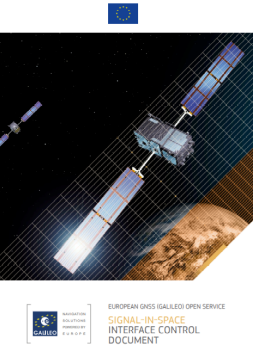The Galileo Signal-in-Space Interface Control Documents (OS SIS ICD, HAS SIS ICD and OSNMA SIS ICD) present the shared boundary across the Galileo satellites and the Galileo receivers for the different services (OS, HAS and OSNMA) respectively.

The Galileo OS SIS ICD presents the shared boundary across the Galileo satellites and the Galileo receivers. When any of the multiple Galileo chipset or receiver manufacturers and application developers design and build their products, they follow the OS SIS ICD. Using the OS ICD, the Galileo satellites can then be correctly acquired, decoded and used by Galileo receivers.
The current OS ICD (version 2.0) was published by European Commission in January 2021. Two complementary notes were issued back in 2018 providing additional information on the I/NAV capabilities and related performance improvements. Over the past years, modifications of the ICD have been rare since they may imply changes on Galileo receivers to exploit the new features. The principle of backward compatibility has always been applied.
The Galileo OS SIS ICD describes the Galileo signal characteristics, Galileo spreading codes, Galileo message structure and message data content:
- Galileo signal characteristics introduce the features of the Galileo satellites frequency bands (E1, E5, E5a, E5b and E6), carrier frequencies, reference bandwidth, modulation, signal polarization and minimum and maximum level of received power on ground.
- Galileo spreading codes for each signal component (E5a-I E5a-Q E5b-I E5b-Q E1-B E1-C) are generated using a tiered code construction. The tiered codes require a primary and secondary code generated and assigned to each Galileo satellite according to the OS SIS ICD.
- Galileo message structure explains the different message types (I/NAV and F/NAV) layouts. Each message is divided in frames, subframes and pages accommodating message data contents. The OS SIS ICD indicates the duration of each division.
- Galileo message contents describe the semantics and formats of all data in the Galileo message structure required by the Galileo receiver to compute a navigation solution (ephemeris, time and clock corrections, service parameters and almanac) and gain access to the Search and Rescue (SAR) Return Link Service (RLS) through the SAR Return Link Message (RLM).
The Open Service documentation is completed with the OS Service Definition Document (OS SDD) and the OS Ionospheric Correction Algorithm for Galileo Single Frequency Users. The Galileo ICD is extended with the E6 message structure detailed in the Galileo E6-B/C SIS Technical Note.
The other new Galileo services, namely the Galileo High Accuracy Service (HAS) and the Galileo Open Service Navigation Message Authentication Service (OSNMA) also have ICDs:
- The Galileo HAS SIS ICD provides all the necessary information to decode the HAS bit frames included in band E6-B to correct the satellite orbit coordinates, on-board clock errors and code biases for both Galileo and GPS space vehicles as implemented in the Initial Phase of the Galileo HAS Service provision.
This document is complemented by the Galileo HAS Internet Data Distribution ICD (HAS IDD ICD), which provides information about the ground interface with the users, applicable for the Galileo HAS corrections delivered through the Internet. This document is available after registration to the Galileo HAS Internet Data Distribution.
- The Galileo OSNMA SIS ICD is devoted to the interface between the Galileo Space Segment and the Galileo User Segment for the OSNMA Initial Service. The OSNMA message structure and its detailed specification and functions are described in this document.
The OSNMA SIS ICD is complemented with the Galileo OSNMA IDD ICD, soon to be published, specifying the interface for the provision of Public Keys and associated certificates. Please note that Galileo OSNMA is still in the Public Observation phase, while the OSNMA SIS ICD already specifies the format of the signal applicable to the Service phase.
Apart from these documents, different Info Notes on new services and features, the Galileo HAS Service Definition Document and diverse guidelines for implementation are also provided on the GSC website.
Media note: This feature can be republished without charge provided the European Union Agency for the Space Programme (EUSPA) is acknowledged as the source at the top or the bottom of the story. You must request permission before you use any of the photographs on the site. If you republish, we would be grateful if you could link back to the EUSPA website (http://www.euspa.europa.eu).